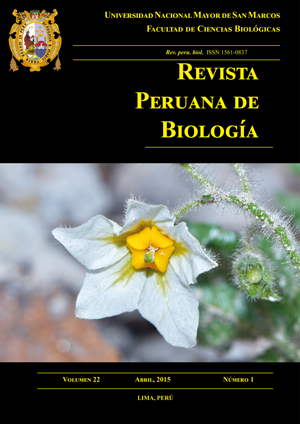Growth by basal branching in two species of Huicungo palms, Astrocaryum carnosum and A. huicungo
DOI:
https://doi.org/10.15381/rpb.v22i1.11123Keywords:
Astrocaryum, Arecaceae, caespitose habit, Peruvian Amazon.Abstract
The basal branching process of Astrocaryum carnosum and A. huicungo is described and its rate and structural expression at the population level is analyzed. Two populations of palms were used in this study, A. carnosum from the Alto Huallaga valley and A. huicungo from the Alto Mayo valley. Branching systems underground were exposed and drawn. For both species, it was established 25 quadrants of 20x20m, in which were counted (i) the number of solitary and caespitose individuals, and (ii) the numbers of axes composing the caespitose individuals. The axes of solitary and caespitose individuals were distributed by growth stages (seedling/juvenile-1/juvenile-2/adult). Seedling and juvenile-1 are not caespitose, basal branching starts in juvenile-2. A. huicungo presents a higher density of axes produced by basal branching than A. carnosum. This branching process in both species by formations of clones from short rhizomes allows an optimized exploitation of space and ensures the continuity of the population over time. However, its role in the spatial propagation of the species is very limited by the shortness of the rhizomes.Downloads
Downloads
Published
Issue
Section
License
Copyright (c) 2015 Miguel Machahua, Francis Kahn, Betty Millán

This work is licensed under a Creative Commons Attribution-NonCommercial-ShareAlike 4.0 International License.
AUTHORS RETAIN THEIR RIGHTS:
a. Authors retain their trade mark rights and patent, and also on any process or procedure described in the article.
b. Authors retain their right to share, copy, distribute, perform and publicly communicate their article (eg, to place their article in an institutional repository or publish it in a book), with an acknowledgment of its initial publication in the Revista Peruana de Biologia.
c. Authors retain theirs right to make a subsequent publication of their work, to use the article or any part thereof (eg a compilation of his papers, lecture notes, thesis, or a book), always indicating its initial publication in the Revista Peruana de Biologia (the originator of the work, journal, volume, number and date).






